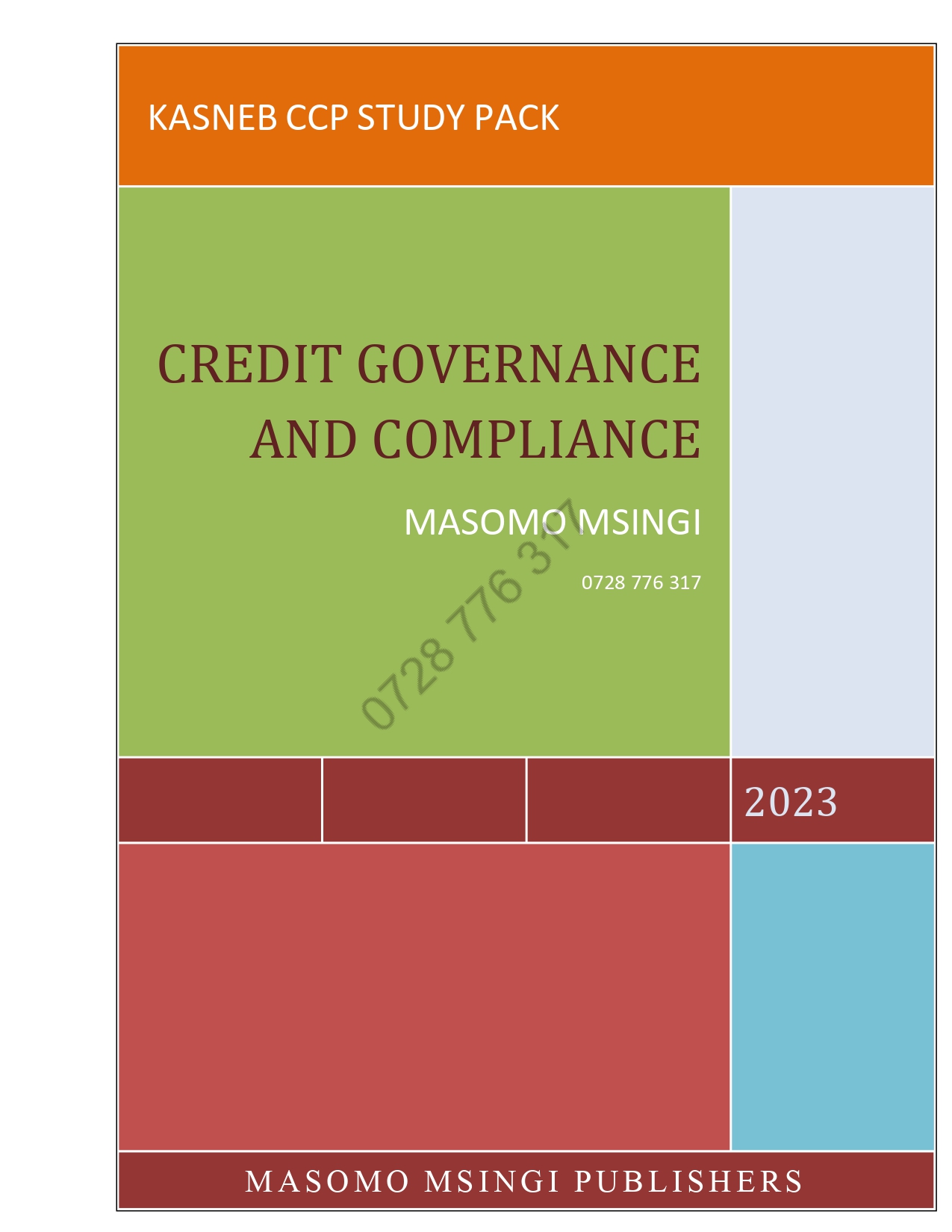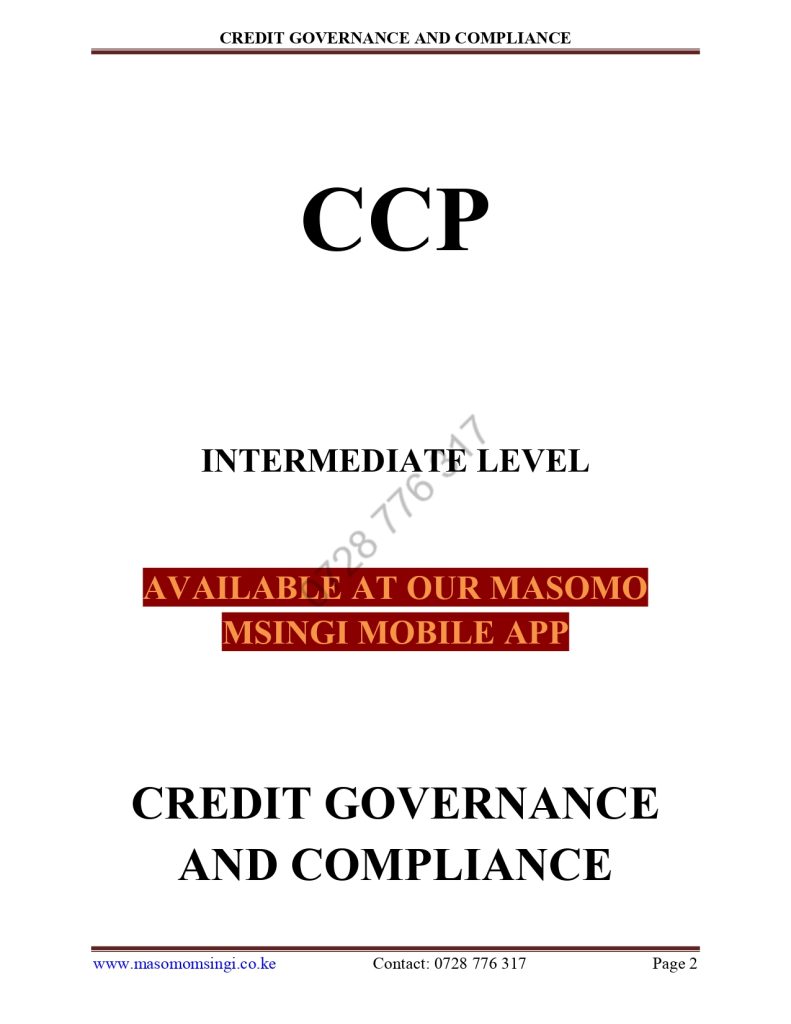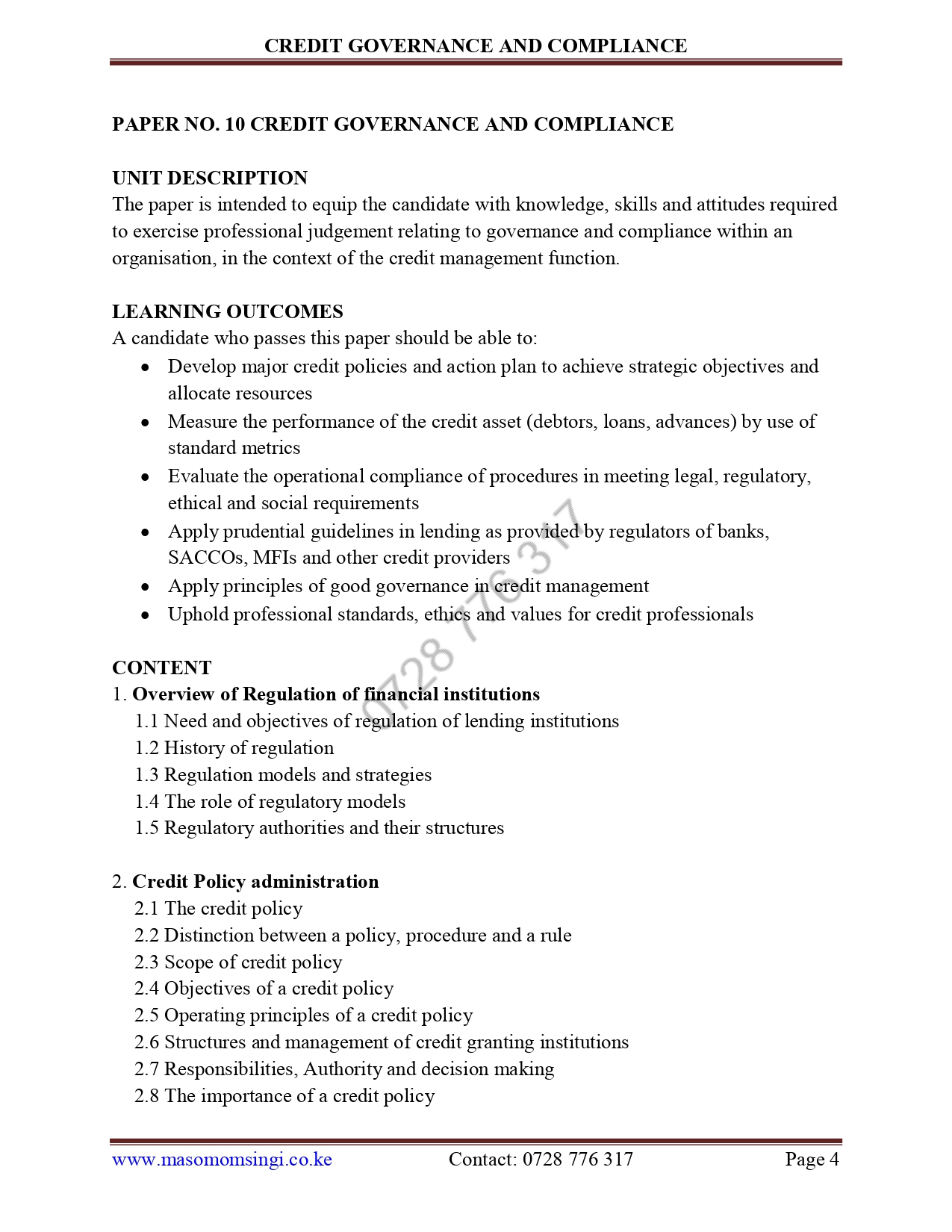SAMPLE WORK
Complete copy of CCP Credit Governance and Compliance is available in SOFT copy (Reading using our MASOMO MSINGI PUBLISHERS APP) and in HARD copy
Phone: 0728 776 317
Email: info@masomomsingi.com
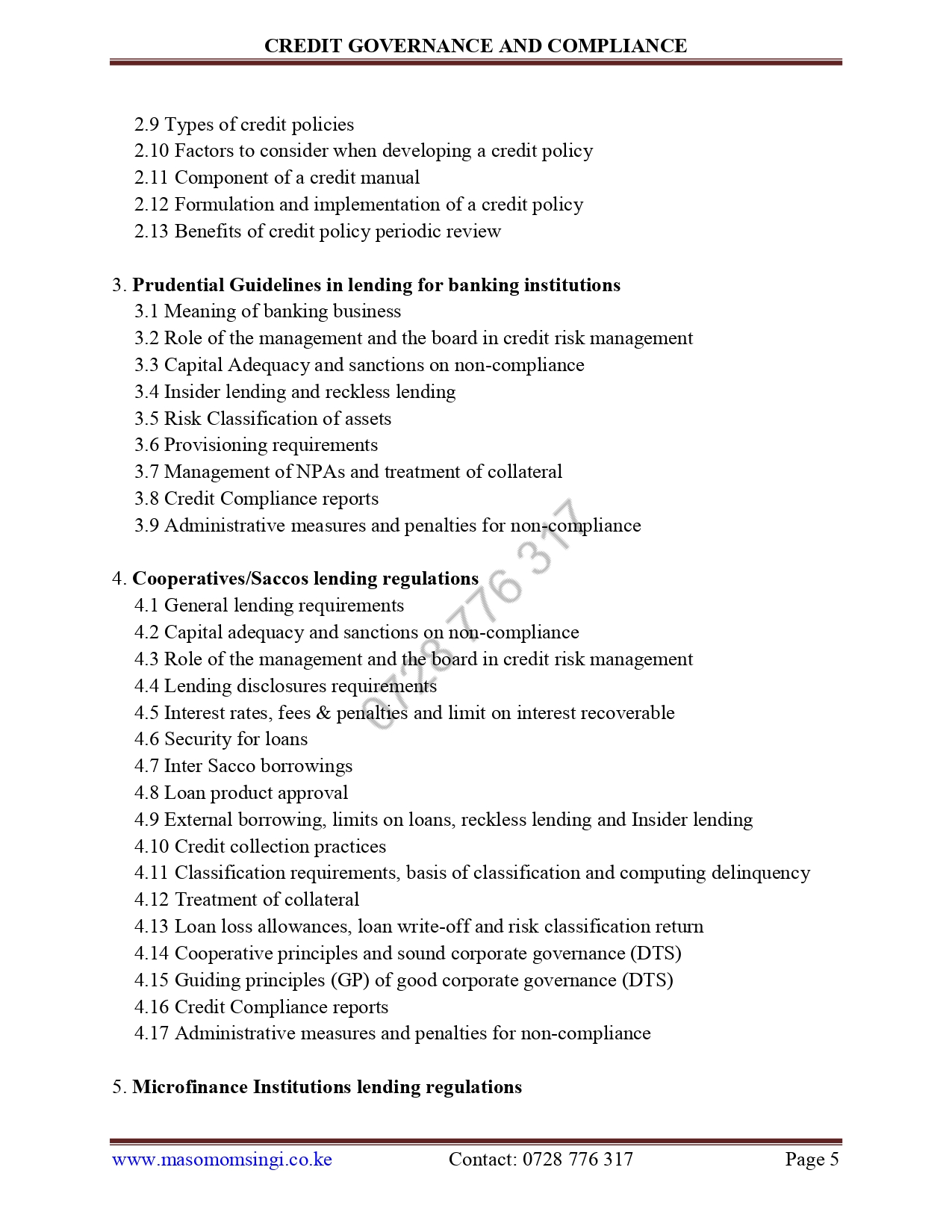
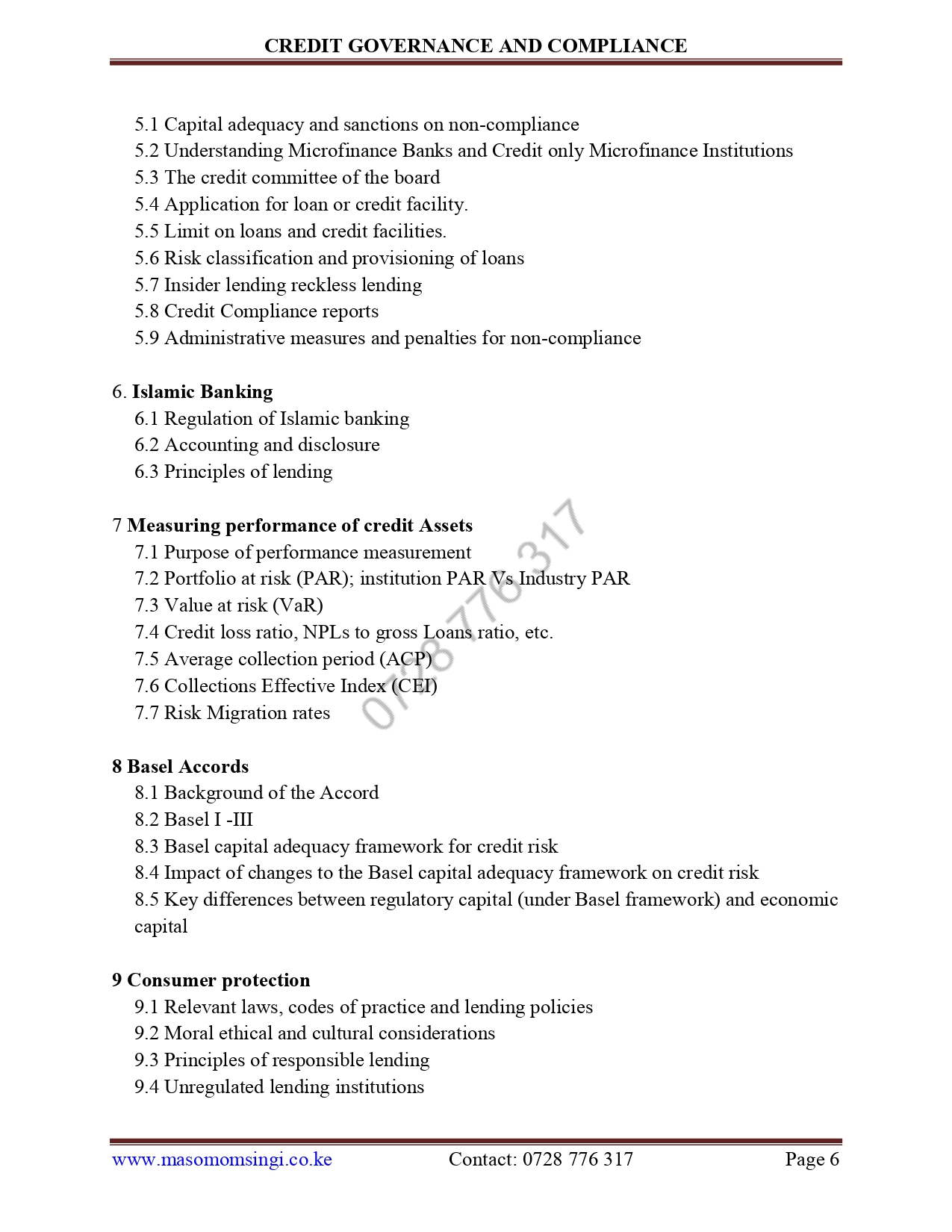
CHAPTER ONE
OVERVIEW OF REGULATION OF FINANCIAL INSTITUTIONS
Financial regulation refers to the rules and laws firms operating in the financial industry, such as banks, credit unions, insurance companies, financial brokers and asset managers must follow. However financial regulation is more than just having rules in place – it’s also about the ongoing oversight and enforcement of these rules.
Legislation (or “statutory law”) is law that has been promulgated (or “enacted”) by a legislature or other governing body. Before an item of legislation becomes law it may be known as a bill, and may be broadly referred to as “legislation” while it remains under consideration to distinguish it from other business.
The Central Bank of Kenya is in various ways guided by the following pieces of legislation:
- Constitution of Kenya 2010
- Central Bank of Kenya Act (2015)
- Banking Act (2015)
- Microfinance Act (2006)
- The National Payment System Act (2011)
- Kenya Deposit Insurance Act 2012
This regulatory structure creates transparency between banking institutions and the individuals and corporations with whom they conduct business, among other things.
Given the interconnectedness of the banking industry and the reliance that the national (and global) economy hold on banks, it is important for regulatory agencies to maintain control over the standardised practices of these institutions.
Need and objectives of regulation of lending institutions
The regulation of lending institutions is intended to protect consumers and ensure the stability of the financial system. The specific objectives of regulating lending institutions include:
- Ensuring that lending institutions operate in a safe and sound manner, with adequate capital and risk management systems in place.
- Protecting consumers from predatory lending practices, such as charging excessive interest rates or fees, or using unfair or deceptive marketing practices.
- Promoting competition among lending institutions, to ensure that consumers have access to a wide range of credit products at fair and reasonable terms.
- Maintaining the stability of the financial system, by ensuring that lending institutions are resilient to economic shocks and that there are mechanisms in place to manage or resolve institutions that fail.
- Provide the framework for prevention of money-laundering and fraudulent activities by institutions
The lending institutions can be broadly classified as banks, non-banking financial companies and microfinance institutions, which are regulated by respective central bank and other governing body in most of the countries.
History of regulation
The history of regulating lending institutions can be traced back to the early days of banking, when governments and central banks began to take steps to control the issuance of money and regulate the activities of financial institutions. However, the form and extent of regulation has evolved over time and varies between countries.
In the United States, for example, the National Banking Act of 1863 established a system of national banks that were subject to federal oversight, and the Federal Reserve System was created in 1913 to provide a central bank and a system of bank regulation. In the aftermath of the Great Depression, the Banking Act of 1933 (also known as the Glass-Steagall Act) further strengthened regulation of banks by creating the Federal Deposit Insurance Corporation (FDIC) to insure deposits and separating commercial and investment banking activities.
In the United Kingdom, regulation of banks can be traced back to the Bank Charter Act of 1844, which established the Bank of England as the central bank and regulator of the banking system. In the second half of the 20th century, the Bank of England’s role as a regulator was expanded to include other financial institutions, and the Financial Services Act of 1986 established the Financial Services Authority as the primary regulator of financial services in the UK.
In most countries, the regulation of lending institutions continues to evolve in response to changes in the financial system and in response to financial crises. For example, after the global financial crisis of 2008, many countries enacted new regulations intended to strengthen the resilience of the financial system and protect consumers from predatory lending practices.
The history of regulation of lending institutions has been shaped by a combination of economic, political, and social factors, with the goal of maintaining stability in the financial system, protect consumers and ensure fair competition among institutions.
Regulation models and strategies
MASOMO MSINGI PUBLISHERS APP – Click to download and access all our materials
There are several different models and strategies for regulating lending institutions, each with its own strengths and weaknesses. Some of the most common models and strategies include:
- Prudential regulation: This approach focuses on ensuring that lending institutions have adequate capital and risk management systems in place to protect against losses. Prudential regulators, such as central banks or specialized financial regulatory agencies, set capital and liquidity requirements for institutions, conduct regular on-site inspections, and have supervisory powers to enforce compliance.
- Conduct of business regulation: This approach focuses on protecting consumers from unfair or deceptive practices by lending institutions. Conduct of business regulators, such as consumer protection agencies or specialized financial regulatory agencies, set standards for disclosure, marketing, and sales practices, and enforce compliance through fines and penalties.
- Market-based regulation: This approach relies on competition among institutions to drive innovation and lower costs. Market-based regulators, such as competition agencies or specialized financial regulatory agencies, promote competition by removing barriers to entry and encouraging new market participants.
- Macroprudential regulation: This approach focuses on maintaining the stability of the financial system as a whole, rather than just the stability of individual institutions. Macroprudential regulators, such as central banks or specialized financial regulatory agencies, monitor the system-wide risks, develop early warning indicators and intervene when needed with tools such as countercyclical capital buffers, leverage ratios etc.
- International coordination: this approach promotes cooperation and information sharing among regulators from different countries to ensure consistency and prevent regulatory arbitrage. Central banks and specialized financial regulatory agencies are often part of global forums such as the Basel Committee on Banking Supervision or Financial Stability Board (FSB) which are responsible for standards for financial institutions.
In practice, many countries use a combination of these models and strategies to regulate lending institutions. The choice of model and strategy depends on a variety of factors, including the size and complexity of the financial system, the level of economic development, and the political and cultural context.
It’s important to note that the regulations are constantly evolving and are being updated as per the changing needs of the economy and to keep pace with innovation and developments in financial services.
SAMPLE WORK
Complete copy of CCP Credit Governance and Compliance is available in SOFT copy (Reading using our MASOMO MSINGI PUBLISHERS APP) and in HARD copy
Phone: 0728 776 317
Email: info@masomomsingi.com
The role of regulatory models
Regulatory models play a crucial role in ensuring the stability and safety of the financial system and protecting consumers from unfair or predatory practices by lending institutions.
The prudential regulatory model is important for maintaining the solvency and soundness of financial institutions. It sets minimum capital and liquidity requirements, and monitors the risk management practices of institutions, to ensure they can withstand financial shocks and continue to meet the credit needs of the economy.
The conduct of business regulatory model is important for protecting consumers by setting standards for fair and transparent practices, such as marketing, disclosure, and pricing. It also creates a framework for dispute resolution and complaints handling mechanisms which helps to ensure that consumers have recourse if they feel they have been treated unfairly.
The market-based regulatory model promotes competition and innovation among financial institutions, which can lower costs and improve services for consumers.
The macroprudential regulatory model helps to ensure the stability of the financial system as a whole by identifying and monitoring system-wide risks, and taking actions to prevent or mitigate them.
The international coordination helps to ensure consistency and cooperation among regulators from different countries. This can prevent regulatory arbitrage and ensure that financial institutions are held to a common set of standards, regardless of where they operate.
All these models and strategies work together to balance the need for maintaining the stability of the financial system, protecting consumers and promoting fair competition among institutions.
Regulatory models play a critical role in the functioning of the financial system by ensuring the stability of lending institutions, protecting consumers from predatory practices, promoting competition and innovation and maintaining the overall stability of the financial system.
Regulatory authorities and their structures
Kenya has several regulatory authorities that oversee the financial sector and ensure the stability and safety of the financial system. Some of the key regulatory authorities and their structures in Kenya include:
- Central Bank of Kenya (CBK): The CBK is the central bank and the main regulator of the banking sector in Kenya. It is responsible for formulating and implementing monetary policy, issuing currency, and supervising and regulating banks and other financial institutions. The CBK has a number of departments that are responsible for different aspects of financial regulation, including the Banking Supervision Department and the Financial Markets Department.
- Insurance Regulatory Authority (IRA): The IRA is the regulator of the insurance industry in Kenya. It is responsible for licensing and supervising insurance companies, and for setting and enforcing standards for the conduct of business by insurance companies. The IRA is also responsible for promoting competition, innovation, and development in the insurance sector.
- Retirement Benefits Authority (RBA): The RBA is the regulator of the retirement benefits industry in Kenya. It is responsible for licensing and supervising pension and provident funds, and for setting and enforcing standards for the conduct of business by these institutions.
- Capital Markets Authority (CMA): The CMA is the regulator of the capital markets in Kenya. It is responsible for licensing and supervising securities exchanges and other securities market intermediaries, and for setting and enforcing standards for the conduct of business by these institutions.
- Sacco Societies Regulatory Authority (SASRA): The SASRA is the regulator of savings and credit co-operative societies (SACCOs) in Kenya. It is responsible for licensing and supervising SACCOs, and for setting and enforcing standards for the conduct of business by these institutions.
All these regulatory authorities work independently to fulfill their mandate and to ensure the stability and safety of the financial system in Kenya. They also work closely with other regulators to ensure consistency and cooperation in the supervision and regulation of different types of financial institutions.
It’s important to note that regulatory authorities in Kenya and other countries are also closely linked to the central bank, which helps to ensure consistency and cooperation in the supervision and regulation of different types of financial institutions.

